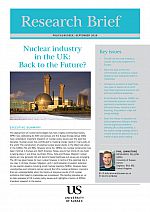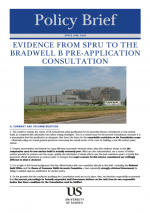Research brief
We created a research brief titled "Nuclear industry in the UK: Back to the future?"
Download the full nuclear industry research brief [PDF 603KB].
This is a legacy document that may not be fully accessible.
Find out about our work investigating nuclear energy and capabilities.
Since the 1950s, nuclear power has contributed to meeting energy needs in many parts of the world. Yet throughout its history, the deployment of nuclear power and technologies has been highly controversial, with nuclear accidents, nuclear proliferation, high cost of nuclear power plants, nuclear terrorism and radioactive waste disposal all key concerns.
Over more than five decades, SPRU has undertaken important research on nuclear policy issues, from safety and waste disposal issues to those of cost and lack of independent policymaking.
Since the 2011 Fukushima Daiichi nuclear accident in Japan, nuclear safety and nuclear energy policy has been extensively revisited in many countries, with many scaling back their nuclear power. Germany plans to close all its reactors by 2022. Yet the UK Government remains enthusiastic about the most ambitious nuclear new build programme in Europe and continues to give unusual emphasis to nuclear power compared with other responses to meeting energy demands and mitigating climate change.
At SPRU, our academics continue to analyse the deep uncertainties and criticisms that remain around the UK’s nuclear ambitions, concerns that are understandable when the history of previous rounds of UK nuclear ambitions that failed to materialise are considered.
Nuclear infrastructures with joint civil and military rationales continue to be the main bone of contention in current global tensions around nuclear proliferation. With particular reference to the UK, but also focusing on other countries, SPRU research on this topic is illuminating an issue that has not previously been acknowledged in civil energy policy debates. This issue is, that the intensity of official commitments to civil nuclear power are to a large extent driven by military motivations around sustaining the industrial base required for the construction, maintenance and operation of nuclear propelled submarines. This work informs current debates in the UK and further afield regarding why in certain countries nuclear technologies continue to be prioritised over increasingly favourable low carbon alternatives.
See also: Shining a light on the UK’s nuclear deterrent
In 2016 Gordon Mackerron and Phil Johnstone submitted evidence to the Welsh Affairs inquiry on nuclear new build. This focussed on the proposed Wylfa development. Mackerron and Johnstone outlined the limited new build experiences of ABWR reactors around the world, and uncertainties in the economics of Wylfa newydd. Proposals for Small Modular Reactors (SMRs) for trawsfynydd were also discussed. Drawing on international experience, and economic and technical assessments, the significant risks of a UK SMR programme were highlighted. This evidence was submitted in written form as well as given at an oral evidence session on 7 March.
Official global reporting of nuclear accidents and incidents has been scrutinised by Professor Sovacool in collaboration with ETH Zurich. The research – Of Disasters and Dragon Kings: A Statistical Analysis of Nuclear Power Incidents and Accidents – suggests that the International Nuclear Event Scale (INES) is inappropriate in indicating the size of major nuclear incidents such as Chernobyl and Fukishima. A probabilistic analysis indicates that a Three Mile Island type or larger accident could occur every 10-20 years. The Three Mile Island accident ranked 5 out of the 7 maximum by INES and was where a reactor failure resulted in radioactive gases being released into the environment. The researchers liken this to the possibility of “Dragon King” events i.e. nuclear accidents that are extremely large and relate to the same system. This raises important issues in costing nuclear power and also ensuring improvements in the safety in the UK as well as internationally.
Part of our research explores the links between the civil and military sectors in relation to the following:
Ever since the early development of nuclear technology accelerated during the Second World War, it has been clear that there are strong links between civil and military applications of nuclear power. Major nuclear industrial infrastructures were built during the War to produce materials for nuclear weapons. Early reactors were designed especially for this purpose. After the War, an entirely different kind of nuclear reactor was developed to fit inside the confined spaces of the submarines, whose stealth and endurance still gives them the key role in the nuclear arsenals of the world’s biggest military powers.
Nuclear infrastructures with joint civil and military rationales continue to be the main bone of contention in current global tensions around nuclear proliferation. Despite many efforts to establish new designs of nuclear reactors, the only ones that have so far been widely adopted for civilian power generation are those that descend from these military designs originally optimised for either the production of fissile materials or submarine propulsion. A key problem for the nuclear industry is that dominant reactor designs were not optimized from the beginning for the production of safe, economic civilian electrical energy. Yet military-derived reactor designs have become so locked-in, that it is now difficult to replace them.
We created a research brief titled "Nuclear industry in the UK: Back to the future?"
Download the full nuclear industry research brief [PDF 603KB].
This is a legacy document that may not be fully accessible.

Many material links between civil and military nuclear technologies are very well documented. Involving types of plutonium, uranium or tritium used in bomb-making, for instance, these material links form the central focus of major international legal and political regimes. Over the past few years, a key strand of research at SPRU has focused more on the less well-understood industrial interdependencies between civil and military nuclear power. Particular attention has been given to the question of how imperatives to sustain national industrial capabilities to construct, maintain and operate nuclear-propelled submarines seems at least partly to drive ambitious nuclear new build agendas in certain countries.
Nuclear ballistic missile submarines are often recognised to be the most complex and demanding industrial artefacts that have ever been developed. It is a big struggle in a globalizing world, to retain the national industrial capacities and expertise to build and operate these extraordinary machines. Without a healthy ongoing national civil nuclear power programme, even the richest countries would find it effectively impossible to cover the enormous costs of the large engineering, regulatory, research and training infrastructures necessary to maintain these nuclear capabilities.
SPRU research is showing that it is the military incentives to maintain this ‘nuclear industrial base’ that are largely driving the otherwise odd intensity of current Government commitments to nuclear power. It is also these aims that are evidently largely responsible for pressures for a new generation of ostensibly civilian ‘small modular reactors’, which are also in reality optimized around military submarine design requirements and so once again poorly suited to commercial power production.
With particular reference to the UK, but also focusing on other countries, SPRU research on this topic is illuminating an issue that has never before been acknowledged in civil energy policy debates. This issue is, that the intensity of official commitments to civil nuclear power are (although typically justified in other ways), to a large extent driven by these undeclared military motivations. As a result, a significant part of the costs of military nuclear capabilities are being effectively subsidized by electricity consumers, in ways that are off the public books and away from policy scrutiny. As nuclear power is increasingly recognized to be prohibitively expensive compared to other low carbon energy options, it is becoming more and more difficult to conceal this problematic situation.
SPRU submitted evidence to the Bradwell B pre-application consultation.
You can download the SPRU evidence as a policy brief [PDF 849KB].
This is a legacy document that may not be fully accessible.

SPRU research in this area aims to help foster more rigorous and accountable policy discussions over key implications of military nuclear infrastructures. We want to help inform debates in the UK and some other countries, over the reasons why nuclear technologies appear to be especially prioritised over increasingly favourable low carbon alternatives. Whatever side of the argument is favoured, the key issues are around protecting healthy democratic debate over crucial areas of policymaking with extremely high stakes.
pre-2016: prior to this SPRU research, no public intervention in any national energy policy debate highlighted military (especially naval) nuclear capabilities as key driver for civil nuclear strategy
pre-2017: many specialist energy and nuclear analysts who by 2018 accept SPRU evidence, initially reject it as a ‘conspiracy theory’